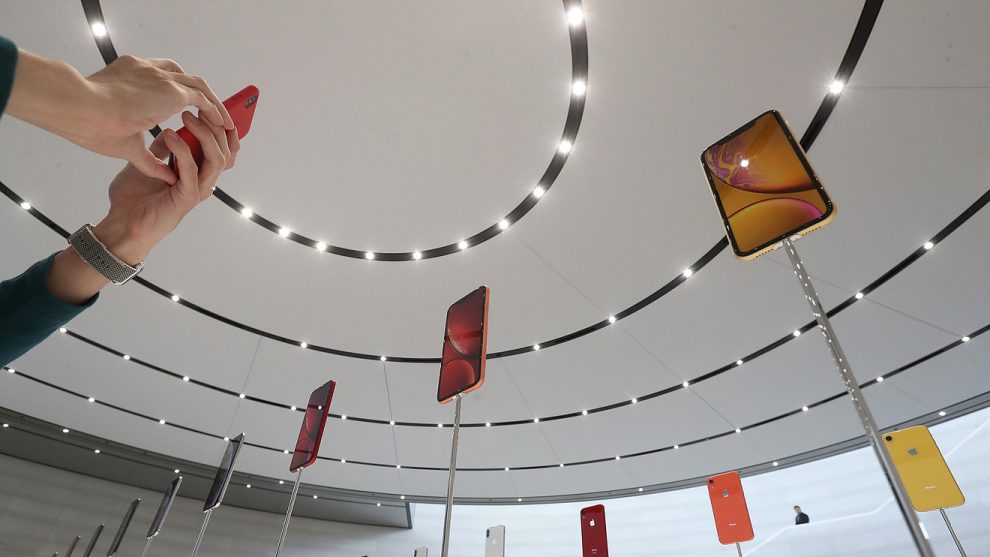
First, they came for the washing machines, but I said nothing because I wasn’t in the market for a washing machine. Then they came for steel, but I have no idea what the steel in my car costs, or where it comes from.
But now they are coming for my iPhone, and millions of American consumers are about to tell President Donald Trump whether this time is different — or not.
The stage was set when the administration threatened last week to extend 25% tariffs to all Chinese goods, and by Monday China’s government retaliated, threatening to increase tariffs on $60 billion of U.S. goods exported to the mainland. For the first time, Apple’s AAPL, -5.81% iPhone is threatened — the flagship of the industry that makes the biggest contribution to the U.S. trade deficit with China, and at least one key to making previously-obscure trade disputes tangible to the masses.
Want to know what tariffs cost? Simple. Your iPhone will cost $160 more if Trump follows through on his tariffs, says Morgan Stanley analyst Katy Huberty. And China ain’t paying.
Really, the argument now is about whether tariffs will make China cry uncle — you know, the way Trump’s banks and bondholders have always cried uncle during his 30-year cascade of foreclosures and forced sales. The idea is that the administration thinks Apple suppliers such as Hon Hai will move production to factories in places like Vietnam or India, pressuring China to give in on intellectual-property protection and other issues.
Read: Here are the stocks to buy if an all-out U.S.-China trade war erupts, says Goldman
So let’s think about time, and negotiating leverage: Like how much time it takes to build U.S. factories that would accomplish what the Trump administration hopes they would. (On the bright side, the administration seems to have abandoned the idea that tariffs would prompt companies to move simple assembly work back to the U.S. to compete with companies that do have phones made in Asia, but outside China).
Think about the 2020 election, and what consumers would think in the event that Apple confronts a holiday season this fall with tariffs in place.
Think about the fact that Trump is currently sitting on a -7 approval v. disapproval margin, according to Real Clear Politics. Several polls are much worse, and the only one materially better is Rasmussen Reports, rated C+ by FiveThirtyEight for its inaccuracy, partisan lean, and methodological problems. Rasmussen missed the generic party vote in last year’s congressional races by nine points — in guess-which-party’s favor?
Think about the fact that China’s leadership, Trump’s negotiating opponent, faces no election, ever, and only indirect popular pressure.
Think about the fact that the one edge Washington politicos believe Trump has in this fight is the perception, incomprehensible to most but persistent, that Trump is an economic wizard. Somehow, Trump actually has a 54-41 approval margin on the economy. That swaying motion you feel is everyone who knows any economics shaking their heads.
Finally, think about the fact that the Standard & Poor’s 500 SPX, -2.41% fell 2.4% Monday and is down 5% since the president began his latest trade fight. And that the selloff is likely to persist as long as the tweets and tariffs do — because back to 2016 the book on Trump has been that his tax-cut plans might stimulate the economy briefly, but his trade policies would more than undo the damage if implemented.
Curiously, Trump seems to become less popular when he actually tries to do his job and behaves less like the reality-show host he long was. His approval rating plunged during the 2017 fight over repealing Obamacare, for example, and even dipped during the talks that led to the tax cut that December.
Those two bills didn’t cost many people real money, especially not in Trump’s own voting coalition. But an estimated 86 million Americans carry iPhones, which they replace often at prices up to $1,000. And Trump responds to signals from the stock market — he’s backed down from trade positions before due to market pressure, including reaching a face-saving deal with Mexico and Canada that hasn’t been approved by Congress.
Do the math. The tariffs will be visible — and visibly paid by Americans, eroding Trump’s already-controversial middle-class-tax-cut brand. The 0.5 percentage-point erosion in U.S. growth that Oxford Economics predicts if tariffs get fully implemented will cut into Trump’s economic-approval rating, the only political card he’s got to reach beyond his base.
Tariffs will delay iPhone replacements, according to Huberty, affecting not just manufacturing assembly jobs overseas but also design and corporate jobs at Apple’s Cupertino headquarters and elsewhere, plus jobs in stores run by Apple, Verizon, T-Mobile and others.
Of course Trump will fold — after salvaging scraps. The only question is how soon he’ll cave and whether that clock begins running before the iPhone tax hits, or after. The 2020 election is 568 days away as of Tuesday.
Plus: Apple drops 5.8% because iPhone owners can sue
Want news about Asia delivered to your inbox? Subscribe to MarketWatch’s free Asia Daily newsletter. Sign up here.






